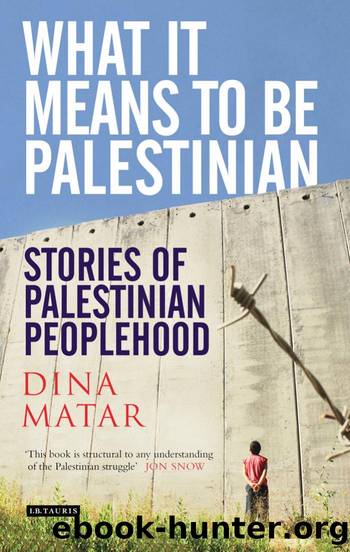What It Means to Be Palestinian: Stories of Palestinian Peoplehood by Dina Matar

Author:Dina Matar [Matar, Dina]
Language: eng
Format: mobi, azw3, epub
Tags: I.B. Tauris, 20th Century, Modern, 21st Century, General, Middle East, History
ISBN: 9781848854574
Publisher: Bloomsbury Academic
Published: 2010-10-30T23:56:24.421037+00:00
Between Romance and Tragedy, 1964â70
103
4 A Palestinian refugee woman, who identifi ed herself as Um Khaled, and her family at Al-Bas camp in Tyre in Lebanon. They are displaced Palestinians from Nahr al-Bared camp following the 2007 battle between the Lebanese army and the Islamist militant group Fatah al-Islam which killed more than 400 people and displaced up to 30,000 Palestinians. Um Khaled feels bitter about her life, but life goes on. Photograph: Tanya Habjouqa.
opponents myself. I have put away my gun now. I am done with fighting. I paint to express my feelings and to tell the world I exist. Paintings can speak and act for you, and they bring hope to the children of the camps. They are as good as guns.
Women are not mere hyphens: Samira Salah27
I was born in Tiberias in 1944, but we lived in Haifa because my father was working in the city. I was one of 11 children, four of them boys. We left in 1948 for Irbid in Jordan, and then continued on to Damascus. I always wanted to find out what was going on, so I followed the news on the radio avidly, and my parents talked to us about Palestine and politics all the time.
I gave my first public speech in 1956, on the aggression against Egypt. I was only in the fourth grade, but I was encouraged by my Matar_88-123.indd 103
9/24/2010 8:23:27 PM
104
What It Means to be Palestinian
teacher, a Syrian with strong pan-Arab nationalist views. I volunteered to talk, and that was the beginning of my political activism. When Gamal âAbdel-Nasser visited Syria in 1958, I went with a group of my classmates to greet him outside the Republican Palace. We put on special clothes to show we were Palestinians, and I wore a hat with the word âPalestineâ sewn across the top.
We elbowed our way to stand close to the balcony where he was standing, and someone took a picture of us with him in the background. I still have that picture.
I joined the studentsâ union and then the womenâs union because I felt we women were oppressed. We continue to see this oppression to this day everywhere, in homes and outside. I owe my determination to my motherâs generation, too, because they were the silent, hard workers who brought us up. My parents married young. It was an arranged marriage, but they were very fond of each other. My mother used to smuggle my father pistols to use in the struggle against the Jewish militias in Palestine, despite the fact she could have been imprisoned by the British for collaborating. My father, who became a member of the Arab Nationalist Movement, was imprisoned many times.
In 1963, I joined the Arab Nationalist Movement. It was then that I met Salah, my husband-to-be. I then became a member of the Popular Front for the Liberation of Palestine, whose vision matched mine. I got married in 1970 and then came to Lebanon, and all the while I was involved in different organizational activities related to the liberation movement and to the womenâs union.
Download
What It Means to Be Palestinian: Stories of Palestinian Peoplehood by Dina Matar.azw3
What It Means to Be Palestinian: Stories of Palestinian Peoplehood by Dina Matar.epub
This site does not store any files on its server. We only index and link to content provided by other sites. Please contact the content providers to delete copyright contents if any and email us, we'll remove relevant links or contents immediately.
| Africa | Americas |
| Arctic & Antarctica | Asia |
| Australia & Oceania | Europe |
| Middle East | Russia |
| United States | World |
| Ancient Civilizations | Military |
| Historical Study & Educational Resources |
Empire of the Sikhs by Patwant Singh(22174)
The Wind in My Hair by Masih Alinejad(4426)
The Templars by Dan Jones(4191)
Rise and Kill First by Ronen Bergman(4013)
The Rape of Nanking by Iris Chang(3518)
12 Strong by Doug Stanton(3059)
Blood and Sand by Alex Von Tunzelmann(2610)
The History of Jihad: From Muhammad to ISIS by Spencer Robert(2208)
Babylon's Ark by Lawrence Anthony(2072)
No Room for Small Dreams by Shimon Peres(1991)
The Turkish Psychedelic Explosion by Daniel Spicer(1990)
Gideon's Spies: The Secret History of the Mossad by Gordon Thomas(1951)
Inside the Middle East by Avi Melamed(1941)
The First Muslim The Story of Muhammad by Lesley Hazleton(1885)
Arabs by Eugene Rogan(1836)
Bus on Jaffa Road by Mike Kelly(1785)
Come, Tell Me How You Live by Mallowan Agatha Christie(1769)
Kabul 1841-42: Battle Story by Edmund Yorke(1650)
Citizen Strangers by Robinson Shira N.;(1536)
